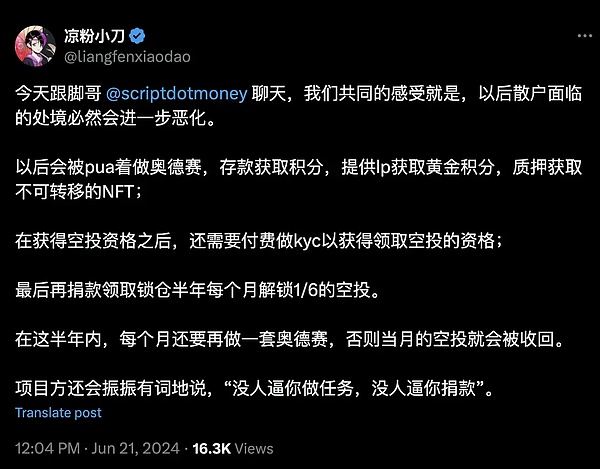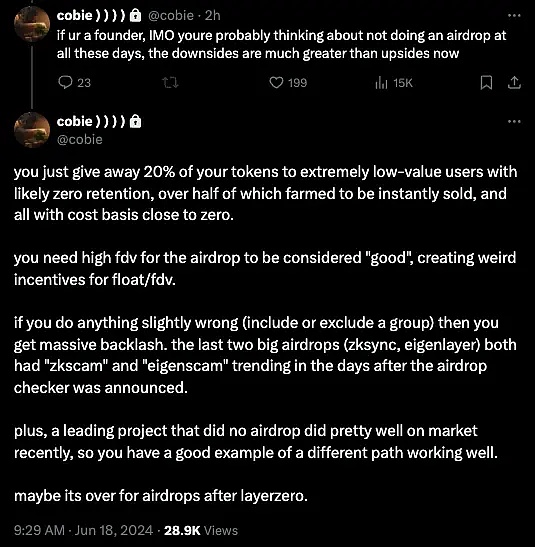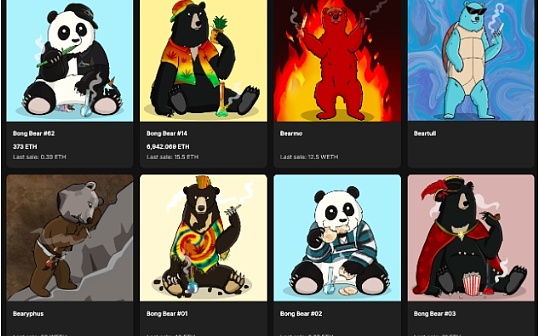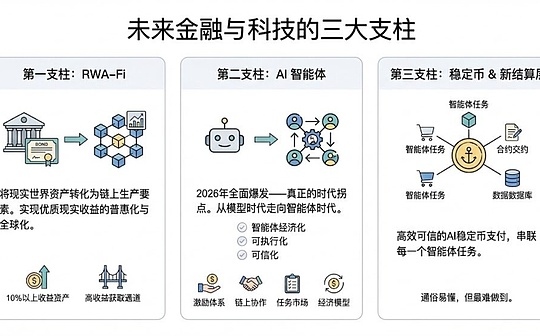
Author: Nianqing, ChainCatcher
Last night, Blast officially opened airdrop application.In the recent anger of “airdrop dead” caused by ZKsync and LayerZero, Blast and founder Tieshun Pacman were also criticized by the community without any surprise.There are three main points of the stutter:
-
The token collection process is irritating
-
The price of tokens is lower than expected after listing, and the revenue of users participating in pledge is lower
-
Top 1% of the activity address needs to wait for a linear unlocking period of 6 months
Specifically, users need to be forced to watch a dozens of minutes of video before receiving the airdrop. Founder Pacman will introduce Blast’s token economics and development plans in detail.In addition, after watching the video, you must download the mobile app and obtain 4 prompt words to finally receive the token.

Secondly, before Blast went public, multiple analysts valued the tokens, and even the more pessimistic valuations were above US$0.03.After the token was launched, Blast’s FDV was only about 2 billion US dollars. In contrast, when L2 such as Arbitrum and Optimism were released, the FDVs were nearly 10 billion US dollars (to a certain extent, it also shows that retail investors no longer pay for VC coins with high FDV.).
However, compared with token prices, some users participating in large-scale pledges reported that their airdrop benefits were very low.For example, NextGen Venture Christian said it had deposited more than $50 million in Blast but received only $100,000 worth of airdrops.Christian also angrily called Blast a fraud project and called Pacman a “serial fraud.”Blast points “Big Brother on the List” @beijingduck2023 pledged about US$10 million, and with a total of 281.2 billion points and 1.22 million gold points, he only received 64,000 BLASTs worth more than US$1,000.In addition, large investors (top 0.1% addresses, about 1,000 addresses) still need to wait for a linear unlocking period of 6 months.
But objectively speaking, Blast has much less negative reviews in the community than in recent years.X user @CryptoWoodBro mentioned that 7% of the first phase of Blast airdrop will be given pledge points, and 7% will be given golden points.Pledge points can be automatically earned only if they lie flat and stay still, which is suitable for giant whale funds; golden points require research on the rules of each project, in-depth participation, and suitable for retail investors who are willing to work in small amounts of funds.In addition, some rules allow points to double/inflate, so Blast airdrops essentially take into account the interests of retail investors, providing retail investors with small amounts of funds with the opportunity to fight big and “hard work to get rich”.
The “short, flat and fast” era has long ended
Although Blast’s airdrop did not check the witches and took into account a certain degree of fairness (particularly taking care of some retail investors) slightly shut down the discussion of “airdrop dead”, the points-based airdrop it represents is still not the return of the Web3 project..
Before airdropping, Blast had “reputation of reputation” due to the points system gameplay.In March, the new points gameplay released online on the Blast main website was accused of PUA.The new rules require users to migrate ETH points to the main network and enjoy 10 times inflation, but users need to pay more than $50 in the Gas fee, which is too expensive for small retail investors, and the expansion coefficient is found to be 0-10 after the user migrates.a random number of times.Although Blast officially modified the bug later, it also left criticism of opaque points calculation rules.Previously, the official also secretly issued a large amount of gold points to certain Dapps.
Related readings:The “haired” person who is trapped in a rat, takes all the big investors, and is deprived of the investment space.》
When the community discussion was noisy, someone once said that whether the PUA of this round of points system ended depends largely on the performance of Blast online. The price of Blast is too much lower than expected, so the airdrop PUA of the classification will be natural.Extinct.”There are also many OGs and KOLs who have threatened to “no longer participate in interactive activities in classification in the future.”
But even if Blast fails, does it mean the point-based airdrop disappear?
Although the community has been complaining about the points system for a long time, winning points is still a common marketing and incentive method for Web3 projects today.
Some of the more well-known unissued projects include:
Scroll released the Scroll Marks user points statistics rules on May 15, mainly counting the scores of users’ bridging data and gas burning data since the release of the Scroll main network on October 10, 2023.Later projects will issue airdrops based on Scroll Marks;
Linea launched the first phase of the Linea Surge Points Program (Volt 1) on May 17. Linea Surge will run for 6 months (6 periods of Volts). There are three main ways to obtain points, namely ecosystem points, recommended points,and early adoption and historical contribution points;
Backpack opened the account trading volume points system in February, and the points ranking will be used as an important reference data for future empty investment spaces or Launchpool projects;
In addition, many projects such as KIP Protocol, KiloEx, Swell, Puffer Finance have launched points activities.Will projects with non-points incentives be better?Not.The situation faced by retail investors will become increasingly difficult. Without a point system, it will be difficult for users to get rid of nodes, go to third-party platforms to swipe tasks, do odysseys, pledge LPs, purchase NFTs with no actual value, etc.

Although the project party’s airdrop is extremely rolled, it does not mean the end of the airdrop era. The Maolu Party did not stop due to one or two setbacks, and there are still a large number of addresses interacting on these unreleased projects.But the era of “short, flat and fast” has come to an end, that is, the era of obtaining airdrops at zero cost and low cost has completely ended.This marks the official entry of the “airdrop industrialization” into a mature period, users have become “Web3 product testing” with certain capital and certain professional knowledge, focusing on the depth of participation.
The airdrop did not die, why did the project party and the hair-brushing party not buy each other?
The project party will never satisfy everyone, but why does the negative emotions brought by this year’s airdrop seem to be particularly prominent?
The most important reason for this situation is the sluggish overall market.Although this round of BTC ETFs has brought about the rise in BTC prices and some altcoins, there is actually not much new capital flowing into the crypto market.All there is is the rotation between the new concept sectors.After being repeatedly beaten by the “value coins” with high valuation and low circulation, retail investors finally completely disgraced them and chose not to pay for fomo.The game of existing funds of VCs, project parties, exchanges, and retail investorsMost projects fell sharply after airdropping and issuing coins because not many people resolved the market.In addition, after the “value coins” lose the wealth-making effect, it is difficult to attract new users to enter.
Secondly, airdrops are no longer a good business for project parties and users.The industrialization of airdrops has caused an irreparable cognitive gap between project parties and users.
The best airdrop in history is Uniswap, which must be no refutation.But no one can copy the airdrop feast unique to pioneers.The so-called good is composed of three factors that are now impossible to complete: users do not have too high airdrop expectations for the project party, extremely low interaction threshold, and high airdrop value.
The “rich-making effect” brought about by airdrops has nurtured the industrialization of airdrops, gradually expanding the cognitive gap between project parties and users..
For the project party, airdrop is a sign of product market compatibility. The project party believes that their products can meet the existing market needs (But how many projects in Web3 have real usage scenarios and core values?),Airdrop is a reward for actual users.This way of thinking directly leads to the arrogance of the project party, as LayerZero founder Bryan said in response to “forced donation”: “If you don’t want to donate, don’t claim tokens. This is not something you have, but someone else provides it.”, here the project party, token airdrops have become “allowed” to users.
For users, the result of the industrialization of airdrops is that they will default to expect every project to be airdropped, and they will participate as “workers” and “farmers”, paying technology, time and costs to help ecological construction and push up the project’s dataand valuation to help them obtain more financing, and they should receive corresponding rewards.
Judging from the results, for the project party, if the airdrop threshold is set low, it means that it will attract “low value” users, and there is a risk of selling after the token is released.Short-term and low-value users will quickly withdraw funds and transfer liquidity to the next “farm” after obtaining airdrops; for users (especially retail investors), even if the amount of funds is small, they will make real contributions during the interaction process.Cost, and usually due to the opaque airdrop rules of the project party, they often face the risk of being counter-attacked.
Uniswap founder Hayden Adams advocates that it can shape a culture of rewarding early adopters, with a more fair and broader value allocation, and simpler self-service adoption, allowing the public to try new things, and achieve “perfect airdrops such as early liquidity and early price discovery.”Maybe there is and can only be achieved that time, after all, Web3 is never a utopia.
Airdrops need to be redefined
Jupiter co-founder Meow made a point in a recent discussion about LayerZero airdrops, saying that “airdrops are gifts. Not rewards, not loyalty programs, nor are they a means of growth. Things are that simple. If you ask youWhat you can get from it is no longer a gift, and it loses its meaning and fails its original sincerity,” he further explained, in order to help protocol developers think about how to do airdrops.
He mentioned that we need to have a clear definition of airdrops.Airdrop is airdrop, incentive is incentive, reward is reward, and growth is growth.The confusion of all these terms leads to problems that exist in airdrops now.
In fact, I agree with his later views.A clear definition is actually more conducive to solving the problems mentioned above and making up for the cognitive differences between project parties and users.Perhaps, the project party should strip away the money spent on user growth and the airdrop budget as a gift.

Encryption KOL Cobie’s discussion on “airdrop is dead”, he believes that the current airdrop situation is difficult to meet the needs of users, and its reputation is easily backfired by small mistakes. Project parties may try better ways to go public without issuing airdrops.
Binance co-founder He Yi also recently posted a statement saying that the killing of Maolu Studio and L2 projects has now turned into a farce, and the era of Maolu may be over.As an ordinary investor, using the ICO in 2017, IEO in 2021, nesting dolls, and even the hair-feeding strategy in 2023 may not be suitable for today’s market.
In the era of “airdrop” industrialization, we should really redefine airdrops and redesign the rules based on this.
Although there is no absolutely perfect airdrop or incentive method, the most important thing for project parties is that what users need is fairness, fairness, or fairness!








